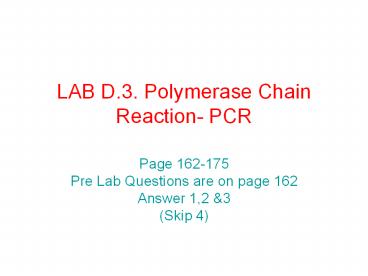LAB D.3. Polymerase Chain Reaction- PCR - PowerPoint PPT Presentation
1 / 18
Title:
LAB D.3. Polymerase Chain Reaction- PCR
Description:
This experiment has considerable 'Dead Time'. To finish in reasonable time the TA's will set up the PCR reaction ... Time at 50-60C to allow primers to 'Anneal' ... – PowerPoint PPT presentation
Number of Views:168
Avg rating:3.0/5.0
Title: LAB D.3. Polymerase Chain Reaction- PCR
1
LAB D.3. Polymerase Chain Reaction- PCR
- Page 162-175
- Pre Lab Questions are on page 162
- Answer 1,2 3
- (Skip 4)
2
This lab is a demonstration
- You will analyze products by gel electrophoresis
3
Sequence of Events
- This experiment has considerable Dead Time.
- To finish in reasonable time the TAs will set up
the PCR reaction before class. - Very important Read protocol toward the end of
the power points. - We will have a lecture on PCR
- Then make agrarose gels to analyze PCR products
4
Today's Protocol
- 1. obtain one Easy Start microfuge tube with
wax coating(contains dNTPs) - 2. Add 2.5 microliters of plasmid template
- 3. Add 2.0 microliters of upstream primer
- 4. Add 2.0 microliters of downstream primer
- 5. Add 2.0 microliters of TAQ polymerase
- 6. Add 16.5 microliters H2O
- 7. Label tube and place in Thermal-cycler
- Control has everything except primers
5
The Polymerase Chain Reaction
- PCR allows one to amplify a specific DNA sequence
millions of times in just a few hours - Employs the basic biochemistry of DNA replication
particularly the concept of the primer
extension - Primer is made complementary to a particular DNA
sequence - When bound to that sequence DNA polymerase can
extend the primer synthesizing a new
complementary DNA strand.
6
PCR
- During PCR, high temperature is used to separate
the DNA molecules into single strands. - Synthetic single stranded DNA sequences of about
20 nucleotides complementary to specific DNA
sequences serve as primers. - Two primers are used to bracket the target
sequence to be amplified - One comp to one strand at the beginning (sense)
- One comp to the other strand at the end (anti
sense)
7
Performing PCR
- Very small amount of DNA sample is mixed with a
buffer solution containing DNA polymerase and
primers - Polymerase (TAQ) is isolated from a thermophylic
bacteria so it will not be denatured at high
temperature - The mixture is taken through replication cycles
consisting of - Time at 94C to denature DNA
- Time at 50-60C to allow primers to Anneal
- Time at 72 C during which DNA polymerase can
extend the primers producing complementary
strands - The DNA sequence between the primers doubles
after each cycle.
8
(No Transcript)
9
(No Transcript)
10
(No Transcript)
11
Agarose Gels
- See page 167 of the manual for preparation
12
Sindbis Virus
- Made up of three proteins
- Lipid Bilayer (membrane)
- Plus polarity single stranded RNA
- Is infectious
- Virus is a hybrid
- RNA and Protein produced by virus
- Membrane produced by host cell
13
Sindbis Structure
E1 E2
C Membrane
14
Cloning Sindbis Genome
15
Sindbis Membrane Proteins
16
Sindbis Genome
Structural Genes
17
Amplification
- We will use primers which flank the gene that
codes for E2
18
Sindbis Genome
E2 Gene
19
From Monday 2005
Marker Cont Exp
Template DNA Target DNA
20
Monday 2006































